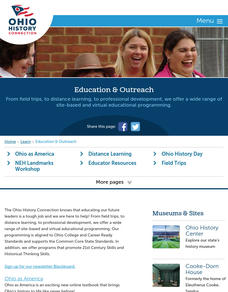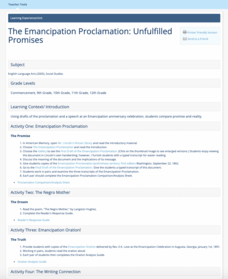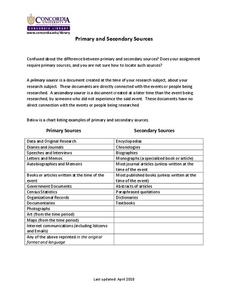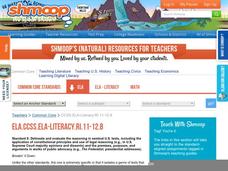K20 LEARN
Reconstruction Treaties Of 1866: The Reconstruction In Indian Territory
The Reconstruction Treaties of 1866 and their impact on the Five Tribes in the United States Civil War are the focus of a lesson that asks young historians to consider how these treaties affected tribal sovereignty. Class members do a...
K20 LEARN
Street Cred: Evaluating Sources
A instructional activity on evaluating sources of information teaches scholars to "think twice" before using a source. Researchers examine a resource's home page, author, and sponsor, as well as the date published and the documentation...
DocsTeach
Who Were Some of the People Who Worked to End Slavery?
As pupils match information to photographs, a document is revealed—the Joint Resolution Proposing the Thirteenth Amendment. Scholars read about some of the people who worked to end slavery, then list each person and at least one way that...
C3 Teachers
Black Genius: How Did Black Genius Help Build American Democracy?
"How did the slavery system undermine the United States' democratic principles?" This question launches a study of how the Preamble to the Declaration of Independence, Article I, Section 2 of the U.S. Constitution, and Article IV,...
C3 Teachers
Emancipation: Does It Matter Who Freed the Slaves?
Scholars generally agree on the emancipation of enslaved people in the United States. This inquiry-based lesson asks high schoolers to consider more than the claims of who freed the enslaved people but the significance of the issues...
C3 Teachers
Civil Rights: What Made Nonviolent Protest Effective during the Civil Rights Movement?
Sit-ins and boycotts, marches and speeches, songs and demonstrations were hallmarks of nonviolent protest of the civil rights movement. Young scholars research primary and secondary source documents to determine what made nonviolent...
C3 Teachers
African Americans and the Civil War: How Did African Americans Experience the Civil War?
To understand African Americans' involvement in the United States Civil War, high schoolers gather evidence from primary source images, census reports, and documents. As a summative performance task, individuals craft an argument,...
Historical Thinking Matters
Spanish-American War: 3 Day Lesson
Why did the United States choose to invade Cuba in 1898? As part of a 3-day lesson plan, your young historians will first develop working hypotheses to answer this question, then work with a variety of historical primary source documents...
Curated OER
In Text (Parenthetical) Documentation
How and when to use parenthetical citations in research writing is the focus of a text-heavy presentation appropriate to high school seniors or college level writers. The bulk of the slides, designed to illustrate a lecture, deal with...
Clark County School District
Hollywood's Take on the Cuban Missile Crisis: Thirteen Days
Watching the film Thirteen Days is an engaging way of acquainting learners with the Cuban missile crisis, and this learning exercise is the perfect accompaniment for viewership! It includes 15 questions for your young historians to...
MLC
Decimals Worksheets
Make sure your students' understanding of fractions is on-point using this series of skills practice worksheets. Covering a variety of topics from basic place value and fraction/decimal conversion, to performing all four operations with...
Curated OER
The Anxiety Workbook For Teens
Teens often face a great deal of worry in their lives, and can be at a loss with how to anticipate and handle their emotions. This workbook is an exceptional resource for both educators and learners alike as a way of supporting teens in...
Curated OER
Understanding the Declaration of Independence
Students work in groups to do a document analyxix of several documents. Students view the Martin Luther King speech, "I Have a Dream." They discuss the Battle of Saratoge. Students give a personal view of the reason the Declaration of...
Curated OER
Using Primary Source Documents
Learners examine copies of primary source documents and determine the document's value to a researcher. They analyze and evaluate the document for bias or contradiction. They know the difference between a primary and secondary source.
Curated OER
Reading Primary Source Documents: Comparing Sources
Students analyze and compare various primary source documents. They formulate historical questions based on the documents.
Curated OER
The Emancipation Proclamation: Unfulfilled Promises
Young scholars perform research into the Emancipation Proclaimation. The document will aid learners in understanding the history and culture of the time of writing. Finally critical thinking skills are used to formulate contextual meaning.
Concordia University
Primary and Secondary Sources
Show your class the difference between primary sources and secondary sources. The first page provides a list of examples of each type of source. While they research, pupils can refer back to the list quickly to make sure they are reading...
Curated OER
Who Do You Know?
Students research and describe the contributions of African-American men and women. They write their notes in a Microsoft Word document. They present their information to the class.
Shmoop
ELA.CCSS.ELA-Literacy.RI.11-12.8
It is no easy feat to wade through legal and political documents. And incorporating this type of informational text into a literature class can also be a challenge. Here’s a resource that includes suggestions for how to address this...
Curated OER
Jackie Steals Home
Students draw on their previous studies of American history and culture as they analyze primary sources from Jackie Robinson and Other Baseball Highlights, 1860s - 1960s in American Memory. A close reading of two documents relating to...
Curated OER
Ladies, Contraband, and Spies: Women in the Civil War
Students use primary sources - diaries, letters, and photographs - to explore the experiences of women in the Civil War. By looking at a series of document galleries, the perspectives of slave women, plantation mistresses, female spies,...
Curated OER
Many Passages: The Voyage of the Slave Ship Brookes
Examine three perspectives of the slave trade - captain, sailor, and captive - through this collaborative analysis activity. Small groups study one perspective with a primary source to analyze. They discern what is a historical fact and...
Curated OER
A Case Study: Slavery and Anti-Slavery in Philadelphia, PA, (17th-19th Centuries)
Eleventh graders work in teams of three. Each team visits a workstation to interpret, analyze, and apply information from documents for their final project. The final project is an exhibit at Independence National Historic Park
Curated OER
Definition Expedition
Students study about three ways to define a term in technical writing, search the Web for scientific text, then copy and paste sections into a Word document. Finally, they use the highlighter feature of Word to highlight examples of...
Other popular searches
- Historical Documents
- Oral History Documents
- Literature Circles Documents
- Teaching With Documents
- Founding Documents
- Word Processing Documents
- Html Documents
- Multimedia Documents
- Using Historical Documents
- Technical Documents
- Notable Historical Documents
- Workplace Documents

























